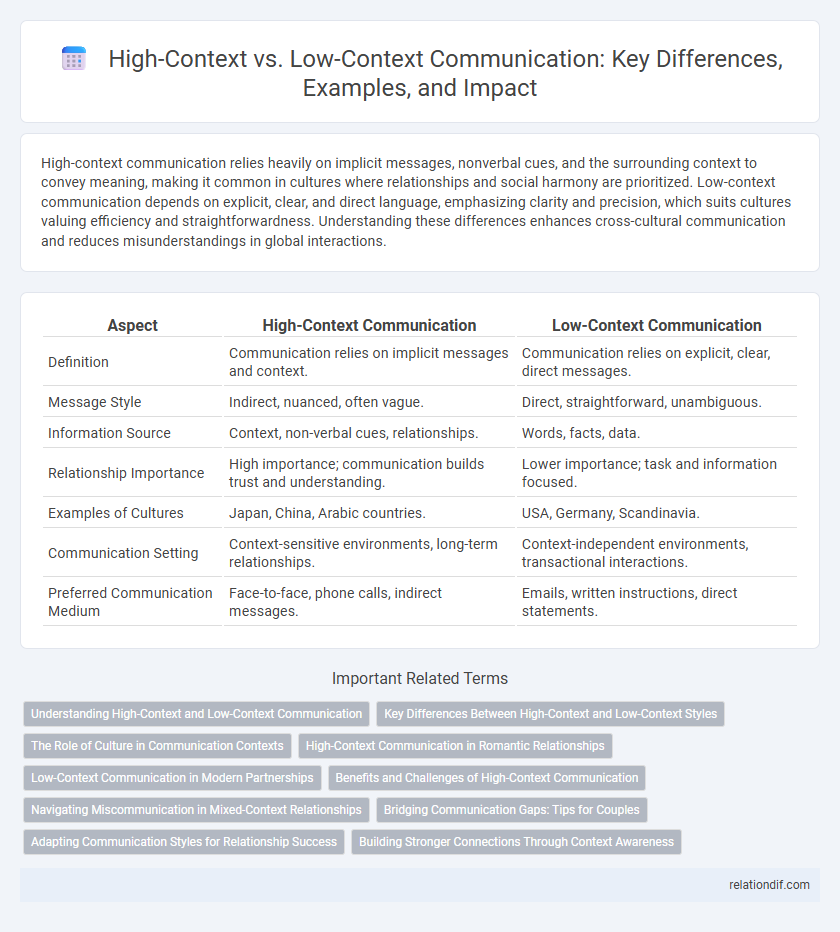High-context communication relies heavily on implicit messages, nonverbal cues, and the surrounding context to convey meaning, making it common in cultures where relationships and social harmony are prioritized. Low-context communication depends on explicit, clear, and direct language, emphasizing clarity and precision, which suits cultures valuing efficiency and straightforwardness. Understanding these differences enhances cross-cultural communication and reduces misunderstandings in global interactions.
Table of Comparison
| Aspect | High-Context Communication | Low-Context Communication |
|---|---|---|
| Definition | Communication relies on implicit messages and context. | Communication relies on explicit, clear, direct messages. |
| Message Style | Indirect, nuanced, often vague. | Direct, straightforward, unambiguous. |
| Information Source | Context, non-verbal cues, relationships. | Words, facts, data. |
| Relationship Importance | High importance; communication builds trust and understanding. | Lower importance; task and information focused. |
| Examples of Cultures | Japan, China, Arabic countries. | USA, Germany, Scandinavia. |
| Communication Setting | Context-sensitive environments, long-term relationships. | Context-independent environments, transactional interactions. |
| Preferred Communication Medium | Face-to-face, phone calls, indirect messages. | Emails, written instructions, direct statements. |
Understanding High-Context and Low-Context Communication
High-context communication relies heavily on implicit messages, nonverbal cues, and the shared understanding within a community, making it prevalent in cultures like Japan and Arab countries where relationships and context shape meaning. In contrast, low-context communication emphasizes explicit, clear, and direct verbal information, typical in cultures such as the United States and Germany, where clarity and specificity are valued to avoid misunderstandings. Recognizing the differences between these communication styles enhances cross-cultural interactions and reduces misinterpretations in global business and social environments.
Key Differences Between High-Context and Low-Context Styles
High-context communication relies heavily on implicit messages, nonverbal cues, and shared cultural understanding, emphasizing relationship-building and context. Low-context communication depends on explicit, direct language where information is clearly stated, prioritizing clarity and efficiency over subtlety. These differences impact how messages are interpreted, trust is developed, and misunderstandings are managed across cultures.
The Role of Culture in Communication Contexts
High-context communication relies heavily on implicit messages, shared experiences, and cultural norms, often found in societies such as Japan and Arab countries where context shapes meaning. Low-context communication, common in cultures like the United States and Germany, emphasizes explicit, direct verbal information with less dependence on situational cues. Understanding the influence of cultural context is essential for effective cross-cultural communication, as misinterpretations arise when communicators fail to recognize these differing communication styles.
High-Context Communication in Romantic Relationships
High-context communication in romantic relationships relies heavily on nonverbal cues, shared experiences, and implicit understanding to convey emotions and intentions. Partners often interpret meaning through tone, body language, and context rather than explicit words, fostering deep emotional connection and intimacy. This communication style is common in cultures where relationships are valued over direct information exchange, enhancing trust and empathy between partners.
Low-Context Communication in Modern Partnerships
Low-context communication in modern partnerships emphasizes clear, direct, and explicit messages to reduce misunderstandings and enhance efficiency. This communication style relies heavily on verbal information, making it essential in multicultural and virtual team environments where shared background knowledge is limited. By prioritizing transparency and detailed exchanges, low-context communication fosters trust and accountability in collaborative business relationships.
Benefits and Challenges of High-Context Communication
High-context communication relies heavily on implicit messages and shared cultural understanding, facilitating deeper relationships and reducing the need for exhaustive explanations in familiar social settings. This communication style enhances trust and cooperation but poses challenges for newcomers or those from low-context cultures, as essential information can be obscured or misinterpreted due to its indirect nature. Navigating high-context communication requires sensitivity to nonverbal cues and context, which can complicate cross-cultural interactions and lead to misunderstandings without clear verbal articulation.
Navigating Miscommunication in Mixed-Context Relationships
Navigating miscommunication in mixed-context relationships requires understanding that high-context communication relies heavily on implicit messages and shared cultural cues, while low-context communication depends on explicit, clear verbal information. Misunderstandings often arise when individuals from high-context backgrounds perceive low-context speakers as blunt or insensitive, whereas low-context individuals may view high-context communicators as vague or evasive. Effective communication strategies include enhancing cultural awareness, clarifying assumptions, and using adaptive language to bridge contextual gaps.
Bridging Communication Gaps: Tips for Couples
High-context communication relies heavily on implicit messages and nonverbal cues, while low-context communication depends on explicit, direct verbal information, often creating misunderstandings between couples from differing backgrounds. To bridge these gaps, couples should prioritize active listening, clarify intentions through open dialogue, and become attuned to each other's communication styles and cultural contexts. Employing empathy and regular feedback helps foster mutual understanding, reducing conflicts caused by assumptions or misinterpretations in both communication types.
Adapting Communication Styles for Relationship Success
Adapting communication styles requires recognizing the differences between high-context and low-context communication cultures, where high-context relies on implicit messages and shared understanding, while low-context emphasizes explicit and direct information. Successful relationship management depends on tailoring messages to the listener's cultural context, using nonverbal cues and contextual hints in high-context environments and clear, concise language in low-context settings. Mastering these distinctions enhances mutual understanding, reduces miscommunication, and fosters stronger personal and professional relationships.
Building Stronger Connections Through Context Awareness
High-context communication relies on shared experiences and implicit messages, fostering deeper understanding and trust within close-knit groups, while low-context communication emphasizes explicit, clear information, reducing misunderstandings in diverse or formal settings. Developing context awareness enhances interpersonal skills by enabling individuals to interpret underlying meanings and cultural cues effectively. Mastering both communication styles strengthens relationships by adapting messages to the audience's contextual needs, promoting empathy and collaboration.
High-Context Communication vs Low-Context Communication Infographic

 relationdif.com
relationdif.com